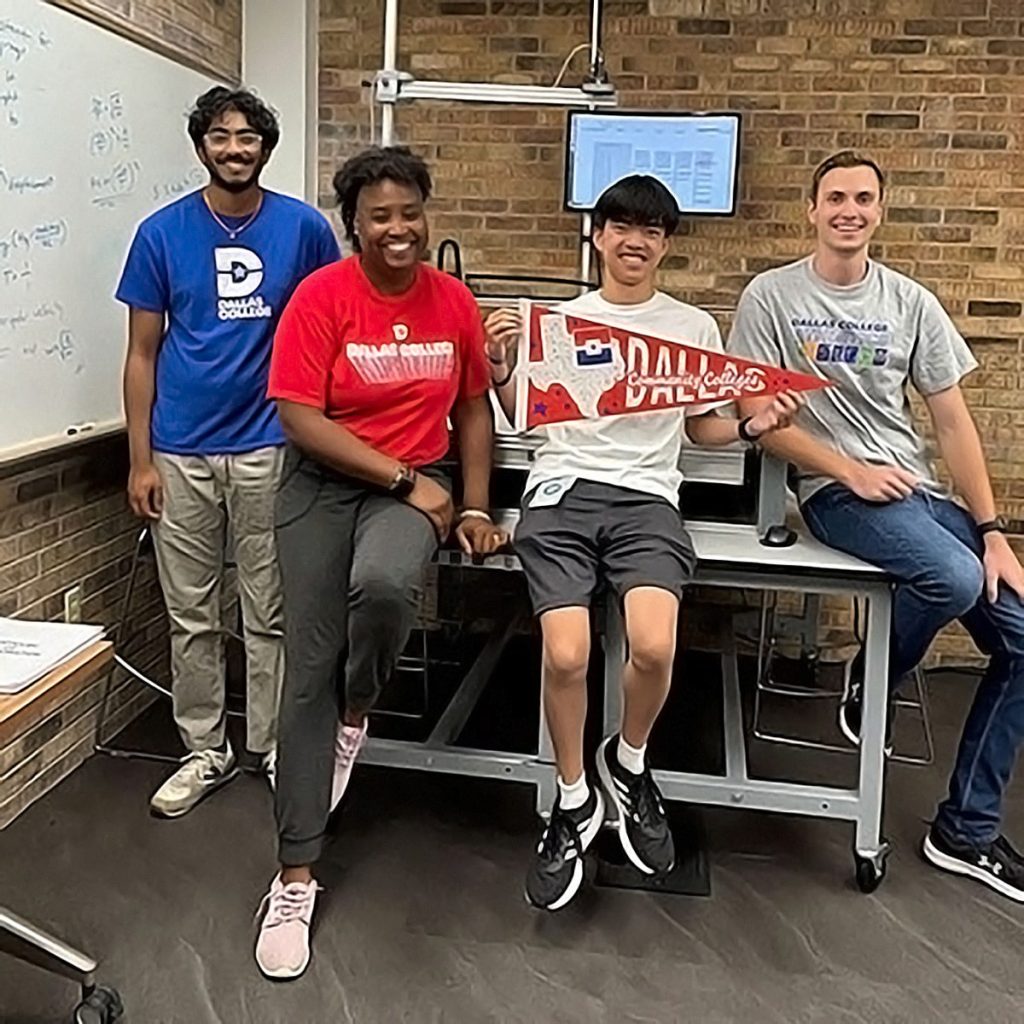(Dallas College) — “This is an engineering professor’s dream come true,” said LaTasha Starr, after one of her teams of students was selected as a Community College Innovation Challenge (CCIC) finalist. They will join 12 other teams from around the country in presenting their project at an Innovation Boot Camp in Washington, D.C. Starr is a professor for the Texas A&M-Chevron Engineering Academy at Dallas College.
The competition, led by the American Association of Community Colleges, in partnership with the National Science Foundation, required students to use science, technology, engineering and mathematics (STEM) to find solutions to real-world problems. The challenge matched what students were already learning in class, said Starr. “My instructional method is industry-based learning, designed to bring together technology, business and entrepreneurship.”
The Dallas College team of Sebastien Vongkaseum, Peter Hansen, Anish Yakkanti and David Navarro will present AMBER (Autonomous Monitoring for Blaze Emergency Response) at the boot camp. Motivated by the devastating Texas Panhandle fire in late February, the team developed a fire monitoring and response system.
“We have infrared technology that detects abnormal heat signatures and smoke. Drones fly out to the location, pick out the heat sources and send exact coordinates as well as photographs to first responders,” said Hansen.

Vongkaseum credits the team members’ diverseness for its success. “All of us came from different backgrounds with different skill sets to contribute to the group,” he said. “Through our engineering course, we were equipped with valuable skills — from identifying the problem to the engineering design phase and every step in between.”
Three Dallas College teams entered the competition, but only one finalist could be selected from each institution.
A team of Leslie Martinez, Owen Weis, Shoaib Ali and Jordan Lawson designed a system that uses cameras, sensors and biometrics to combat distracted driving. Martinez said their project was widely applicable to the public. “It’s accessible to anyone — truck drivers but also parents of first-time drivers,” she said.
Most important, all of the students entering the CCIC competition gained critical experience in presenting their ideas. “There’s nothing more important than that because you know nothing will happen with these ideas unless you’re able to present them,” said Weis.
Students in the Texas A&M-Chevron Engineering Academy are co-enrolled at Dallas College and Texas A&M University College of Engineering. After one or two years of taking core classes at Dallas College Brookhaven Campus, students move to Texas A&M to complete their degrees in one of more than 20 engineering majors.
As students prepare to transition to the Texas A&M campus in the fall, they pointed out some advantages of the program.
• Peter Hansen was drawn to the versatility of an engineering degree. “The program at Dallas College offered smaller classes, more one-on-one with the professors, especially in introductory courses. I am grateful I took this opportunity because I feel very confident in what I’ve learned,” he said. “One thing I didn’t expect was to have such a good community at Dallas College. I made some great friendships. I think that’s not something I would find so easily at such a big university. Since we’re all moving down to A&M, we’ll have each other.” Hansen will major in aerospace engineering and is interested in aircraft design, especially experimental aircrafts.
• Sebastien Vongkaseum said he’s always liked taking things apart to see how they worked, and he knew engineering was for him after taking a 3D modeling class in high school. While he’s wanted to attend Texas A&M for his whole life, he had to explore other options when he didn’t get accepted into the A&M engineering program. Then, he discovered the Engineering Academy at Dallas College. “I’m really happy with the decision I made,” he said. “It’s an excellent program with a direct path into [Texas] A&M engineering majors, without having to come in as a transfer.” Vongkaseum plans to pursue either mechanical or aerospace engineering and hopes to one day work in the airline industry.
• Leslie Martinez has always been good at creating things from scratch and decided she wanted to be an engineer at age 4. A native of College Station, she came to Dallas College to play soccer and found out about the Engineering Academy. “It worked out perfectly because it gave me the opportunity to get a little bit ahead of people transferring to Texas A&M,” she said. The program helped confirm her interest in engineering. She said her classmates have been very supportive. “We’ve grown really tight, and we all study together and look forward to doing that when we move to College Station.” Her focus will be data engineering, and she hopes to one day enter the banking industry.
• Owen Weis started at Dallas College unsure of what field he wanted to pursue. “I knew I wanted to shoot a little higher and challenge my mind. I found the idea of mixing creativity and STEM fields together was perfect for me,” he said. “If you want to be successful in engineering, it’s extremely important to ask questions and communicate with your teachers. The student to teacher ratio at Dallas College is amazing.” He has enjoyed connecting with the other engineering students at the academy. “I’m going to have so many connections in a million different fields,” he said. Weis would like to be an artificial intelligence and machine learning engineer and is interested in human/robot engineering and the autonomous vehicle industry.
Dallas College’s AMBER team will travel to Washington, D.C., for the Innovation Boot Camp, June 10-14. The boot camp will provide professional development, mentoring and coaching designed to build strategic communication and entrepreneurial skills. Students will also attend an engagement opportunity with STEM leaders and Congressional stakeholders on Capitol Hill, and a pitch session in front of a panel of industry and entrepreneurial professionals to determine the winning teams.




